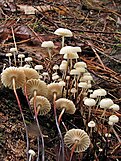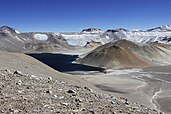Wikipedia:Today's featured article
|
Today's featured article Each day, a summary (roughly 975 characters long) of one of Wikipedia's featured articles (FAs) appears at the top of the Main Page as Today's Featured Article (TFA). The Main Page is viewed about 4.7 million times daily. TFAs are scheduled by the TFA coordinators: Wehwalt, Dank and Gog the Mild. WP:TFAA displays the current month, with easy navigation to other months. If you notice an error in an upcoming TFA summary, please feel free to fix it yourself; if the mistake is in today's or tomorrow's summary, please leave a message at WP:ERRORS so an administrator can fix it. Articles can be nominated for TFA at the TFA requests page, and articles with a date connection within the next year can be suggested at the TFA pending page. Feel free to bring questions and comments to the TFA talk page, and you can ping all the TFA coordinators by adding " |
Featured article candidates (FAC) Today's featured article (TFA):
Featured article tools: |
From today's featured article
Marasmius rotula, the pinwheel mushroom, is a fungus in the family Marasmiaceae. Widespread in the Northern Hemisphere, it was first described scientifically in 1772 by Giovanni Antonio Scopoli. The mushrooms are characterized by thin whitish caps up to 2.0 cm (0.8 in) wide that are sunken in the center and pleated with scalloped margins. The wiry black hollow stalks measure up to 8.0 cm (3.1 in) long by 1.5 mm (0.06 in) thick. On the underside of the caps are widely spaced white gills, attached to a collar encircling the stalk. The mushrooms grow in groups or clusters on decaying wood such as moss-covered logs and stumps. Spore release is dependent upon sufficient moisture. Dried mushrooms may revive after rehydrating and release spores for up to three weeks, much longer than most gilled mushrooms. Although the mushrooms are not generally considered edible, they produce a unique peroxidase enzyme that is attracting research interest for use in bioengineering applications. (Full article...)
From tomorrow's featured article
Ronald Reagan (1911–2004) was an American politician and actor who served as the 40th president of the United States from 1981 to 1989. Reagan graduated from Eureka College in 1932 and began to work as a sports broadcaster in Iowa. In 1937, he moved to California, and became a well-known film actor there. From 1947 to 1952, and from 1959 to 1960, Reagan served as the president of the Screen Actors Guild. He was defeated in his run for the Republican presidential nomination in the 1968 election as well as the 1976 election, but won both the nomination and election in the 1980 election. As president, Reagan implemented new political initiatives as well as economic policies, advocating a laissez-faire philosophy, but the extent to which these ideas were implemented is debatable. The policies, dubbed "Reaganomics", included substantial tax cuts implemented in 1981. (Full article...)
From the day after tomorrow's featured article
Incapillo is a Pleistocene-age caldera – a depression formed by the collapse of a volcano – in La Rioja Province, Argentina. It is part of the southernmost volcanic centre in the Andean Central Volcanic Zone (CVZ). Subduction of the Nazca Plate beneath the South American Plate is responsible for most of the volcanism in the CVZ. Volcanism commenced in the Incapillo region 6.5 million years ago, forming the high volcanic edifices of Monte Pissis, Cerro Bonete Chico and Sierra de Veladero. Incapillo is known to have erupted the Incapillo ignimbrite 0.52 ± 0.03 and 0.51 ± 0.04 million years ago; this has a total volume of about 20.4 cubic kilometres (4.9 cu mi). A caldera with dimensions of 5 by 6 kilometres (3.1 mi × 3.7 mi) formed during the eruptions. Later volcanism generated more lava domes within the caldera and a debris flow in the Sierra de Veladero. The lake within the caldera may overlie an area of ongoing hydrothermal activity. (Full article...)




